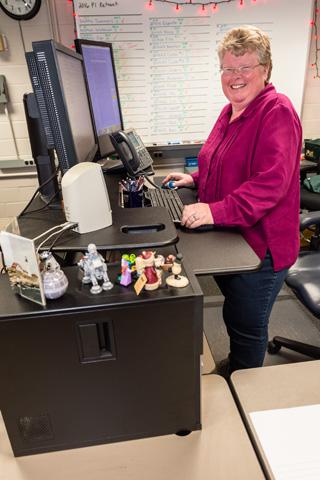Ergonomics is “the scientific study of people at work,” with the goal of reducing stress and eliminating injuries associated with overused muscles, bad posture, and repeated tasks, according to the Centers for Disease Control and Prevention (CDC). The Occupational Safety and Health Administration (OSHA) states that working ergonomically reduces muscle fatigue, increases productivity, and decreases the number and severity of work-related musculoskeletal disorders (MSDs). MSDs affect the muscles, nerves, and tendons, and are a leading cause of lost workdays due to injury or illness.
One step that OSHA recommends to help protect workers from MSDs is to evaluate employee workstations and processes. This evaluation enables the employer to identify and assess ergonomic problems in the workplace before they result in MSDs. At NCI at Frederick, the Environment, Health, and Safety (EHS) directorate conducts such assessments when evaluating staff workstations.
“Ergonomics is fitting a job to a person,” said Ashley Shoemaker, senior occupational safety specialist, EHS. “Everyone is different, so not every workstation or task is designed to accommodate everyone.”
What to Look for in an Evaluation
Factors taken into account during an evaluation include identifying excessive force and localized pressure, repetitive motion, and awkward posture. Shoemaker said other factors that are addressed in the evaluation are the effects of existing medical conditions and tasks performed outside of work that may also include repetition.
“For computer workstations, our most common recommendation has to do with the position of the employee’s keyboard,” Shoemaker said. “The position of the employee’s chair and the height of [his/her] monitor are relative to where the keyboard is positioned. Additional recommendations may include a more supportive/adjustable chair, the position of the chair, use of a foot stool, and a more ergonomic computer mouse (such as the RollerMouse).”
Workstation evaluations are not strictly for office settings. Shoemaker said EHS conducts ergonomic evaluations for several different job functions outside of the traditional computer workstation, including employees working within laboratories (pipetting, bench work, working inside biosafety cabinets and chemical fume hoods), animal facilities (autoclaving, cage changing, cage washing, bottle filling stations, animal procedures), and material handling.
Shoemaker added that EHS conducts approximately two to six workstation evaluations a month. There is no charge for EHS to evaluate a process or workstation. EHS also has several ergonomic products available for employees to try, such as computer and lab chairs, computer mice, and foot stools.
How Evaluations Benefit Employees
Tammy Schroyer, publications coordinator at Scientific Publications, Graphics & Media (SPGM), requested an ergonomic evaluation by EHS for her computer workstation shortly after she had back surgery in late 2014. Years prior to Schroyer’s surgery, she experienced hand problems related to carpal tunnel and arm pain. At that time, she was advised by EHS and switched from a standard mouse to a more ergonomic trackball mouse and has been symptom free for years. However, the pain in her back after her surgery prompted the request for a workstation evaluation.
Schroyer explained that after her back surgery, standing gave her some relief from the pain. After Schroyer’s workstation was evaluated, Shoemaker made several recommendations, including replacing Schroyer’s desk with a height-adjustable desk. This type of desk allows Schroyer to convert from a seated workstation to a standing workstation. A computer application is also available that notifies the employee when to sit and stand.
“I was very uncomfortable; my chair wasn’t comfortable, so I tried several other chairs in the department until I found one that helps with the pain,” Schroyer said. “In order to vary my position at my workstation, I would have to take frequent breaks and walk, which isn’t a bad thing, it just slowed down my workflow considerably. Being able to stay at my workstation and change my working position allows me to complete my tasks in a timely manner while relieving the discomfort in my back.”
Schroyer added that it did take some time to adjust to a height-adjustable workstation.
“Adjusting to the changing positions has taken some getting used to; it’s different, but my back is feeling better every day,” Schroyer said. “I have modified the standing/sitting time intervals on the Varidesk application to slowly adjust to the changing positions, which has been helpful in making the transition.”
Evaluating an employee’s workstation allows EHS to point out necessary adjustments that may be difficult for an employee to identify from his or her perspective, Schroyer said. She added that she would recommend an ergonomic evaluation to her coworkers.
“EHS provided several ergonomic solutions (foot rest, wrist pad) for me to try out, which was very helpful in determining if that solution would be helpful,” she said. “The wrist pad that I tried quickly became a favorite with my co-workers and we eventually ordered that wrist pad for five of our workstations.”
To schedule an ergonomic evaluation, employees may contact Laura Cody at 301-846-7335 or laura.cody@nih.gov.


